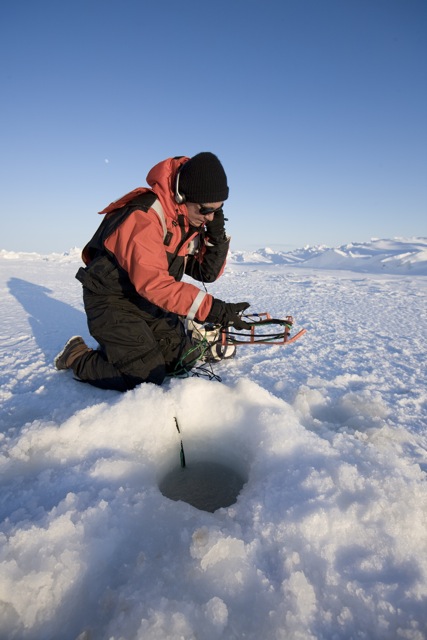Dr. Sue Moore, NOAA/ Alaska Fisheries Science Center, National Marine Mammal Laboratory, is conducting research with acoustic sonobouys, hydrophones, and qualitative observations of marine mammal distributions. The use of acoustic sonobouys has become a reliable tool in detecting the distinctive calls of large whales in offshore waters, such as the Bering Sea. The sonobouys are deployed over the side of the ship approximately 1-2 miles from the Healy, to minimize ship noise, as it approaches a sampling station. A hydrophone is deployed through a hole in the ice when the scientific teams are able to go out on the ice. Marine mammals have calls that are unique to each species and the animal's behavior.

The primary objectives of Dr. Moore's acoustical research in marine mammal studies: 1) to identify the species such as gray whale, bowhead whale, walrus, bearded seal, ringed seal, ribbon seal or any other species; 2) detect any sound patterns indicating behavior; 3) detect any ambient noise in the background; and 4) to record the acoustics for further analysis at the lab to differentiate the number of individuals relative to numbers seen during observations.
Baleen whales are unique by having horny plates that hang downward from their upper jaws. Bowheads feed by swimming through the water with their mouths open to strain out zooplankton from the surface to the bottom of the ocean. Gray whales feed by sucking up sediment from the sea floor and straining out small invertebrates with their baleen.
Bowhead whales (*Balaena mysticetus*) are the only baleen whales that spend their entire lives near sea ice. Bowheads are well adapted for arctic and subarctic waters. The Bering Sea stock is the only population of bowheads to survive in sizable numbers during the commercial whaling period of the late 1800's. The current population estimate is between 6,000-10,000 whales.
Bowheads winter in the Bering Sea in the polynyas (consistent open water areas in the leeward side of land) and at the edge of the pack ice. If they are traveling through areas with ice cover, they have the ability to push ice up to two feet thick creating hummocks (air pockets) under the ice, or blow holes to the surface allowing them to breathe. They follow the sea ice north through the Bering Strait during late March and April. As they reach the Chukchi Sea, they migrate eastward along the coast of Alaska to the <span class="tx-tooltip" tabindex="0">Beaufort Sea<span class="tx-tooltip-text" id="polartrec_vocabulary-1448">The Beaufort Sea lies to the north of Alaska and the Yukon and Northwest Territories.</span></span> where they summer. From August to October, they migrate back to the Bering Strait following two distinct migration route, one takes them over to Russia and the other follows Alaska as they follow the formation of the ice pack. By November, bowheads are back to the northern Bering Sea.
Bowheads are important animals for Alaskan natives. Bowheads have been significant for subsistence hunting and cultural activities for the Inupiaq and Yupik for the past 2,000 years. Hunting is closely regulated and managed by the Alaska Eskimo Whaling Commission. Each village is allotted a quota for subsistence activities. Perry Pungowiyi of Savoonga, Alaska, onboard the Healy to assist the walrus tagging team, is a known expert whaling captain and is teaching me traditional ecological knowledge of the region.
<img class="standalone-image" src="/files/members/craig-kasemodel/images/pungowiyiperryhealysciencenetwork.jpg" alt="Perry Pungowiyi" title="Perry Pungowiyi, Savoonga, St. Lawrence Island, Alaska. {Image courtesy of the Healy Science Network.}" width="300" height="295" />
Gray whales (*Eschrichtius robustus*) that are seen in Alaskan waters are from the California stock. Typically, the California stock migrates between Baja California and the Bering and Chukchi Seas each year. A round trip distance in one year is over 10,000 miles (16,000km). They winter along the Baja peninsula in December and January to calve in the warm waters of Mexico. The whales begin their northward migration in February and follow the Pacific coastline. They arrive in the southern Bering Sea in April-May reaching St. Lawrence Island in May-June. They spend their summer and early fall in the northern Bering Sea and the Chukchi Sea before migrating southward in October.
Gray whales are mainly bottom feeders. In the areas where they are known to feed in the northern Bering Sea and Chukchi Sea, up to 20,000 amphipods per square yard have been found by Soviet researchers. Their average daily consumption has been estimated to be 2,600 pounds (1,200kg).
However, gray whales are beginning to shift their migration patterns. Grays have been sighted and calls have been recorded in the northern Bering Sea and southern Chukchi Sea during the wintertime in recent years. Bowhead patterns are shifting northward as well. They have been seen off of Barrow in late summer in recent years.
These changes maybe a response to changes in the benthic environments or too warming waters due to climate change of the Bering Sea and Chukchi Sea. The impact of these behavior patterns is relatively unknown. There will be more competition with the walrus and bearded seals for the prey base of the benthic macro invertebrates. The Bering Sea <span class="tx-tooltip" tabindex="0">Ecosystem<span class="tx-tooltip-text" id="polartrec_vocabulary-1420">An ecological community together with its environment, functioning as a unit.</span></span> is a great example of the complexities of a dynamic, interrelated system. The Bering Sea <span class="tx-tooltip" tabindex="0">Ecosystem<span class="tx-tooltip-text" id="polartrec_vocabulary-1420">An ecological community together with its environment, functioning as a unit.</span></span> Study is a great example of scientists from many disciplines working together to understand the dynamics of the ecosystem and documenting changes to the ecosystem.
**Reference:**
Dr. Sue Moore, conversations
Answer to the mystery audio file is...Write in to Ask the Team!


Comments